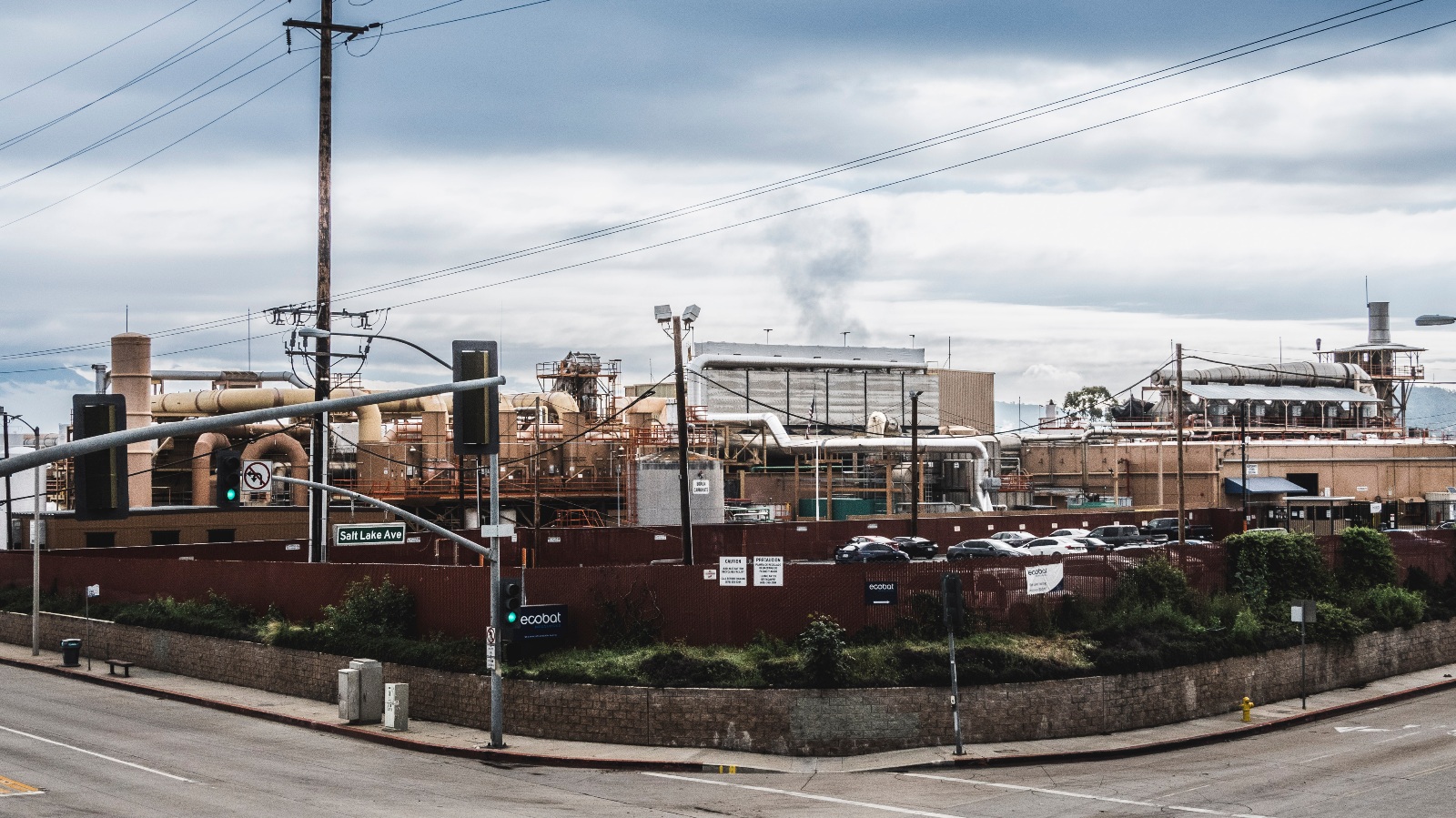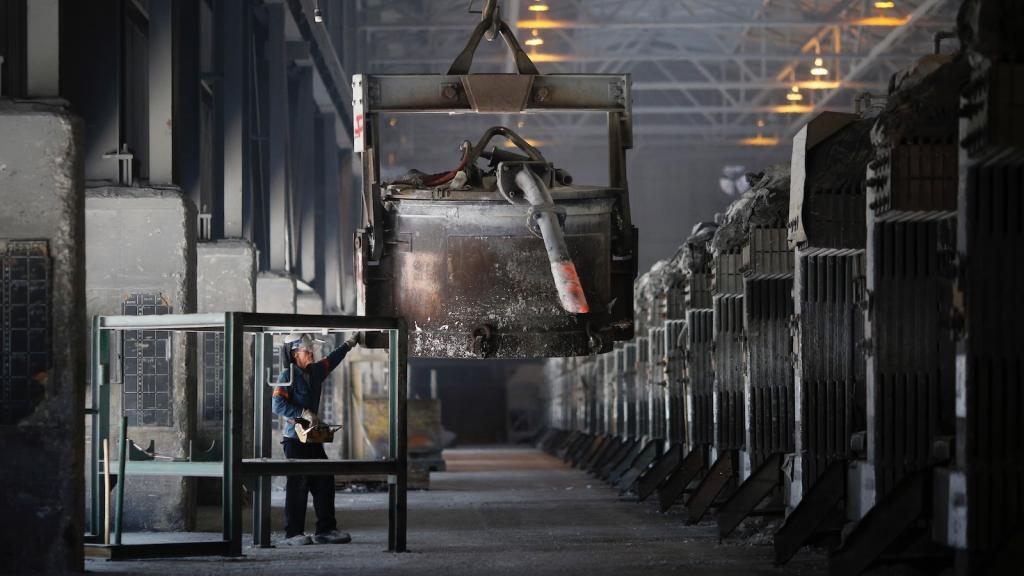This story is being co-published with Public Health Watch.
West of the Rockies, just one lead battery recycler remains in the United States. If your car battery conks out in downtown Seattle or the Sonoran desert, it will probably be hauled to Ecobat, a lead smelter half an hour east of downtown Los Angeles.
Ecobat’s facility in City of Industry melts down 600 tons of batteries and scrap every day. A conveyor belt takes the batteries to a hammer mill where they’re cracked open and slammed into pieces. Then a furnace blasts them with 1,000 degrees of heat. The resulting ingots or “pigs” of lead then ride on, to become batteries once again.
Nationally, about 130 million car batteries meet this fate each year. Fewer than a dozen smelters do this work in the U.S. No other consumer product in the country closes its recycling loop so completely.
But the crucial business of smelting lead is also a very dirty one.
Lead is a neurotoxin; no known levels of it are safe. People who breathe airborne particles of lead or accidentally put it in their mouths — especially children — can suffer nerve disorders and developmental problems. The smelting process itself can create a cancer risk. In addition to lead, it can send arsenic, hexavalent chromium, formaldehyde and other chemicals into the air.
California has some of the tightest toxic regulations and strictest air pollution rules for smelters in the country. But some residents of the suburban neighborhoods around Ecobat don’t trust the system to protect them.
Tens of thousands of people live in the bedroom communities of Hacienda Heights, La Puente, and Avocado Heights, including some just hundreds of feet from the edge of the company’s property. Uncertainty, both about the safety of Ecobat’s operation going forward and the legacy of lead it has left behind, weighs heavily on them.
For decades, thousands of pounds of lead poured out of the smelter’s stacks. Soil testing has revealed high levels of lead on some properties over the years, but hasn’t led to a full investigation. Although pollution controls have squashed airborne lead to a fraction of its historical highs, Ecobat — known until recently as Quemetco — has amassed nearly $3 million in regulatory penalties since 2020.
The facility is operating under a permit that expired almost nine years ago. The Department of Toxic Substances Control, or DTSC, which oversees California’s hazardous waste laws, has sent back the company’s application for renewal three times. Once the filing is complete, DTSC will release a draft permit to the public for comment.
But the release date listed on the department’s website keeps shifting — from February, to March, to April, and as of this week, May.
In the meantime, long-brewing disputes among residents, the company, and regulators are again erupting into public view.
Laws don’t mean much, say neighborhood advocates, if nobody enforces them.
“The regulators, they back down,” said Rebecca Overmyer-Velázquez, a coordinator with the Clean Air Coalition of North Whittier & Avocado Heights. “That’s really our biggest problem.”

In recent months, the dispute has taken on more of an edge. Younger activists impatient with the lack of progress are leading their own inquiry into soil contamination. Ecobat is suing the state over decisions related to the facility. Court filings and lawyers’ threats showcase a bitter and growing divide on questions of public health, responsible product management, and environmental safety.
“What they’ve really been denying the community is the ability to really call the question, should this facility, based on its past operation, receive a renewal of its hazardous waste permit?” said Angela Johnson Meszaros, an attorney at Earthjustice, which represents the Clean Air Coalition. “The community’s position is no. And I think that they have the receipts for why the answer is no.”
Ecobat did not make anyone available for an interview. In a written response to questions, Dan Kramer, a spokesman, said the company is “continuously committed” to protecting public health. “Ecobat’s number one priority is safety — for our employees, their families, and the people living and working in the communities surrounding our facility.”
At issue are not only how California protects public health going forward but also what regulators are willing to do about the past.
The Clean Air Coalition’s Overmyer-Velázquez wants her neighborhood to avoid what happened when another lead smelter closed south of downtown Los Angeles. Exide Technologies may have contaminated as many as 10,000 homes in predominantly Latino, working-class neighborhoods. When it abruptly shut down after 90 years, lawmakers and regulators vowed that Exide would pay to clean up neighborhood-level soil contamination. But in 2020 a bankruptcy court allowed the company to abandon the property, and the cleanup remains incomplete. The cost is ballooning, and so far Californians are paying for it.
Overmyer-Velázquez wants the Ecobat facility shut down, or moved away from densely populated Los Angeles County.
“This place has clearly demonstrated it cannot be a good neighbor,” she said.
DTSC did not make anyone available for an interview. In a written statement, a spokesman for the department said that it has made significant improvement to the permitting process, and that a decision on the facility’s permit “will be grounded in the latest scientific evidence regarding the potential impact of Ecobat’s operations on public health and the environment.” DTSC denied that the process has been delayed.
Half a century ago, after the Cuyahoga River burned in Ohio and as New York’s Love Canal raised national alarms about toxic waste, the Golden State was ahead of the game. California was vocal about the need to limit hazardous waste, to handle it safely, and to keep it local, rather than shipping it somewhere else, where laws are weaker. The state set stringent controls on storage and processing and began requiring permits for facilities. The company then called Quemetco filed for its first operating permit — a temporary one — in 1980.
But some of California’s management plans never materialized; some oversight, starved for staffing and funding, fell to shreds. It took 25 years for regulators to grant Quemetco a full hazardous waste permit.
Early on, environmental officials flagged reasons for concern about the lead smelter. State and federal regulators issued an order and a consent decree in 1987 because of the facility’s releases of hazardous waste into soil and water. An assessment from that time found “high potential for air releases of particulates concerning lead.”
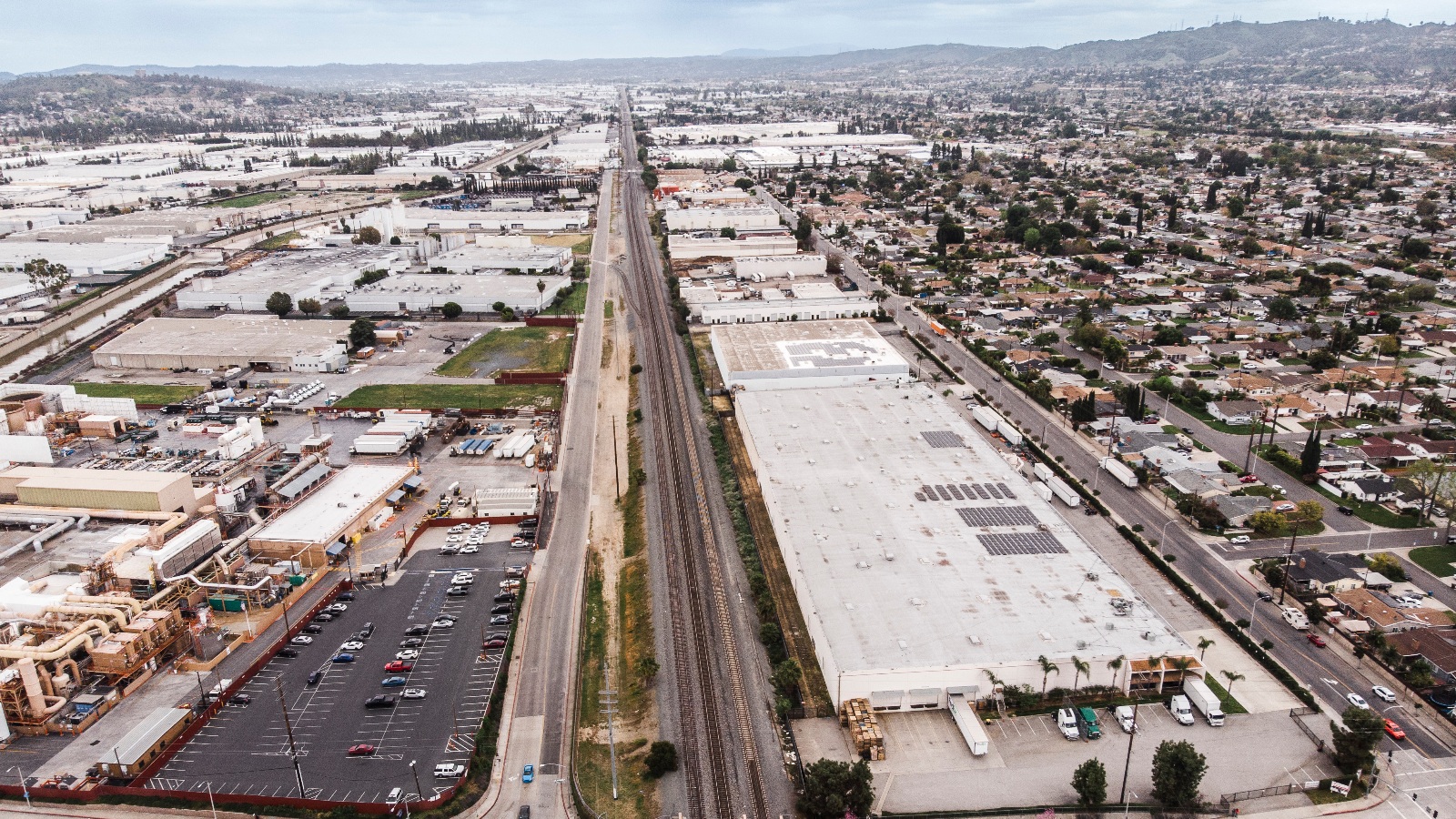
It wasn’t illegal back then for Quemetco to send pollution straight into nearby San Jose Creek, or to dump battery waste into the dirt on a corner of the property without any formal containment. In 1987 alone, according to the federal Toxics Release Inventory, Quemetco reported that it had released nearly 4 tons of airborne lead from its stacks. That was okay, too.
By the 1990s, however, the science about lead was piling up, finding that the health hazards of even low levels of exposure were problematic, especially for children.
In the bedroom communities around Quemetco, neighbors took notice. At a public meeting in 1996, they asked why the permitting process was taking so long.
DTSC’s Phil Chandler, a soil geologist who was working on the facility’s permit at the time, answered the crowd. He explained that the delay was understandable.
“There was an awful lot of firms, like Quemetco, they came in the door, and said, ‘We want a permit.’ And they came all at once,” Chandler told residents back then. “So that’s been a problem.”
More people began raising questions about lead-related health impacts.
Jeanie Thiessen, a special education teacher at a public school in the area, wanted her students to be tested for lead exposure. “Many exhibit signs of neuropsychological problems, cognitive impairments, become easily agitated, and have generally arrested development,” she wrote in a DTSC questionnaire. “Surely it is not normal to have so many children with learning disabilities come from so small an area.”
“I grew up with a lot of those kids,” said Duncan McKee, a longtime critic of the facility who lives in Avocado Heights. He says those worries were common. Looking back, he added, “I think at that point [regulators] started taking it a bit more seriously. Maybe.”
When DTSC finally granted Quemetco a permit in 2005, it didn’t end the communities’ concerns about health and safety.
In Los Angeles, lead smelters are overseen by the South Coast Air Quality Management District. It requires large polluters to submit health hazard assessments that calculate potential cancer risks stemming from their emissions. Quemetco’s assessment in 2000 revealed that it had the highest calculated cancer burden in Los Angeles County, not only because of lead, but also because of other carcinogens involved in the process: arsenic, benzene and 1, 3 butadiene.
That health hazard assessment led to tighter pollution controls at the smelter. In 2008, Quemetco installed an advanced air system called a wet electrostatic precipitator, or WESP. Before the scrubber was installed, the additional cancer risk from the facility for people in the surrounding area was 33 in 1 million, well above the threshold at which polluters are required to cut emissions and notify the public. In the company’s next assessment, that risk had dropped to 4 in 1 million.
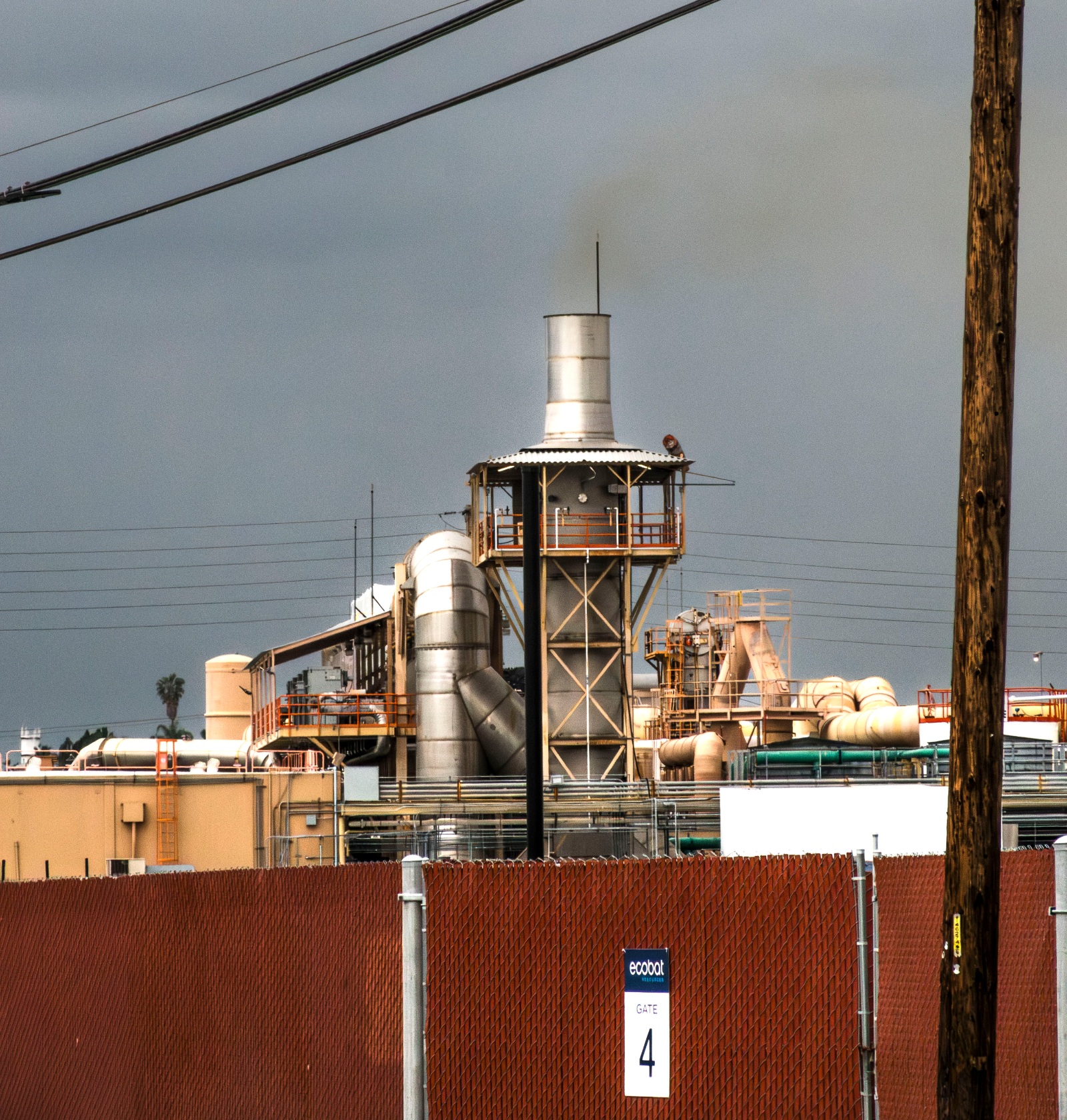
Today, emissions from the company, now known as Ecobat, are well within South Coast’s smelter-specific lead limit. But regulatory problems at the facility remain stubbornly frequent.
South Coast has written Ecobat up for violations 20 times since 2005. Just four years ago, the agency issued a relatively rare $600,000 fine for failing to meet federal and state-level standards. In a press release, South Coast noted that because of lead exceedances, the facility had to temporarily reduce operations.
During DTSC’s most recent 10-year compliance period for the smelter, 2012-2022, Ecobat accrued 19 violations of the most serious type. On one visit, for example, regulators found cracks in the floor of a battery storage area, where acid, lead, and arsenic could leak. In some cases, according to the state’s online records repository, the facility was out of compliance or violations had been in dispute for years. The state’s lawyers filed a civil complaint based on some of these violations and later settled it for $2.3 million. Ecobat paid half the money to the state and half to nonprofits that promote school health and knowledge of local environmental issues.
In its written response to Public Health Watch, the company characterized “nearly all” of the violations as “technical disagreements between Ecobat and DTSC over environmental monitoring systems in place at the facility.”
“None of the alleged violations involved allegations that Ecobat had improperly handled or released hazardous waste or caused any environmental impacts to the community,” said Kramer.
On its website, Ecobat emphasizes that it “has invested close to $50 million installing and maintaining new pollution control equipment and monitoring devices.” That includes the WESP, which Kramer said “was not necessary to meet Ecobat’s risk reduction obligations or any other regulatory mandates.” Instead, Kramer said, the installation of that scrubber was voluntary, and at significant expense to the company.
Questions remain about where and whether the soil may be contaminated in neighborhoods around Ecobat; how much of the pollution in the soil can be attributed to the smelter; and what, if anything, the company can be forced to clean up.
The facility itself reported to the federal government that its stacks ejected thousands of pounds of lead particulate into air each year through most of the eighties, and hundreds of pounds of airborne lead annually for another couple of decades after that.
Roger Miksad, president and executive director of the Battery Council International, a trade association, argues that it’s often hard to identify the source of lead in an urban environment. The 60 freeway is nearby, for example: gasoline once was leaded, and some brake pads for cars are made with lead. Older paints also contain the toxin.
“The number of other sites, be it from lead paint or anything else, I’m sure are innumerable,” Miksad said. “It’s not [Ecobat’s] responsibility to clean up someone’s underlying mess just because they happen to use the same chemical.”
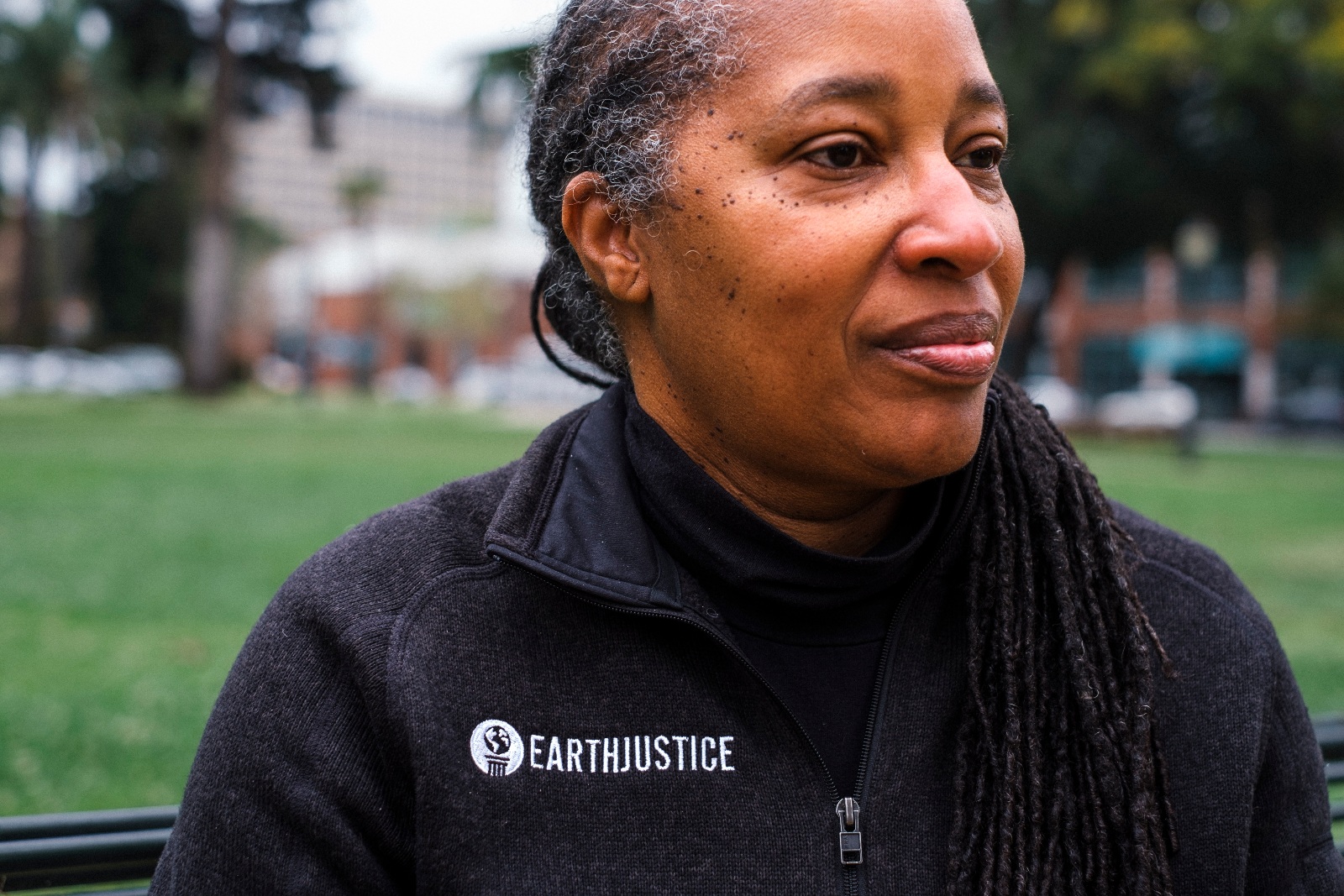
But to the community and its advocates, tracing the lead is a matter of common sense.
“If you have a range of metals coming out of your stack, and if you have them going into the air, it just falls to the ground,” says Earthjustice’s Johnson Meszaros. “It has to; it’s just basic physics.”
Earlier this year, the U.S. Environmental Protection Agency announced that in areas where there are multiple potential sources of lead, screening for further action would begin where the toxin was found at 100 parts per million in soil. California’s screening level is more aggressive: 80 parts per million.
When DTSC sampled more than 50 sites within a mile of Ecobat in the 1990s, it found lead well above both those levels. At one house, lead was measured at 660 parts per million; at another property, sampling found 1,100 parts per million. But nothing more happened until 2016, when DTSC ordered Quemetco to test soils beyond its fenceline for the first time.
The company’s sampling revealed lead exceeding 80 parts per million in soil at most, if not all, of the residential properties visited. The state ordered the company to do more follow-up work, this time testing along lines radiating outward from the facility. Sampling found lead in some areas, but DTSC said the existing sampling plan is “not comprehensive and thereby the findings are not conclusive. Additional sampling is necessary to confirm the extent of facility related impacts in the community.”
At Los Angeles County’s other lead smelter, the now-shuttered Exide plant in Vernon, soil sampling found high levels of contamination in residential areas as far as 1.7 miles away. But in 2022 a federal district judge determined that DTSC had failed to prove Exide’s pollution could have caused that contamination.
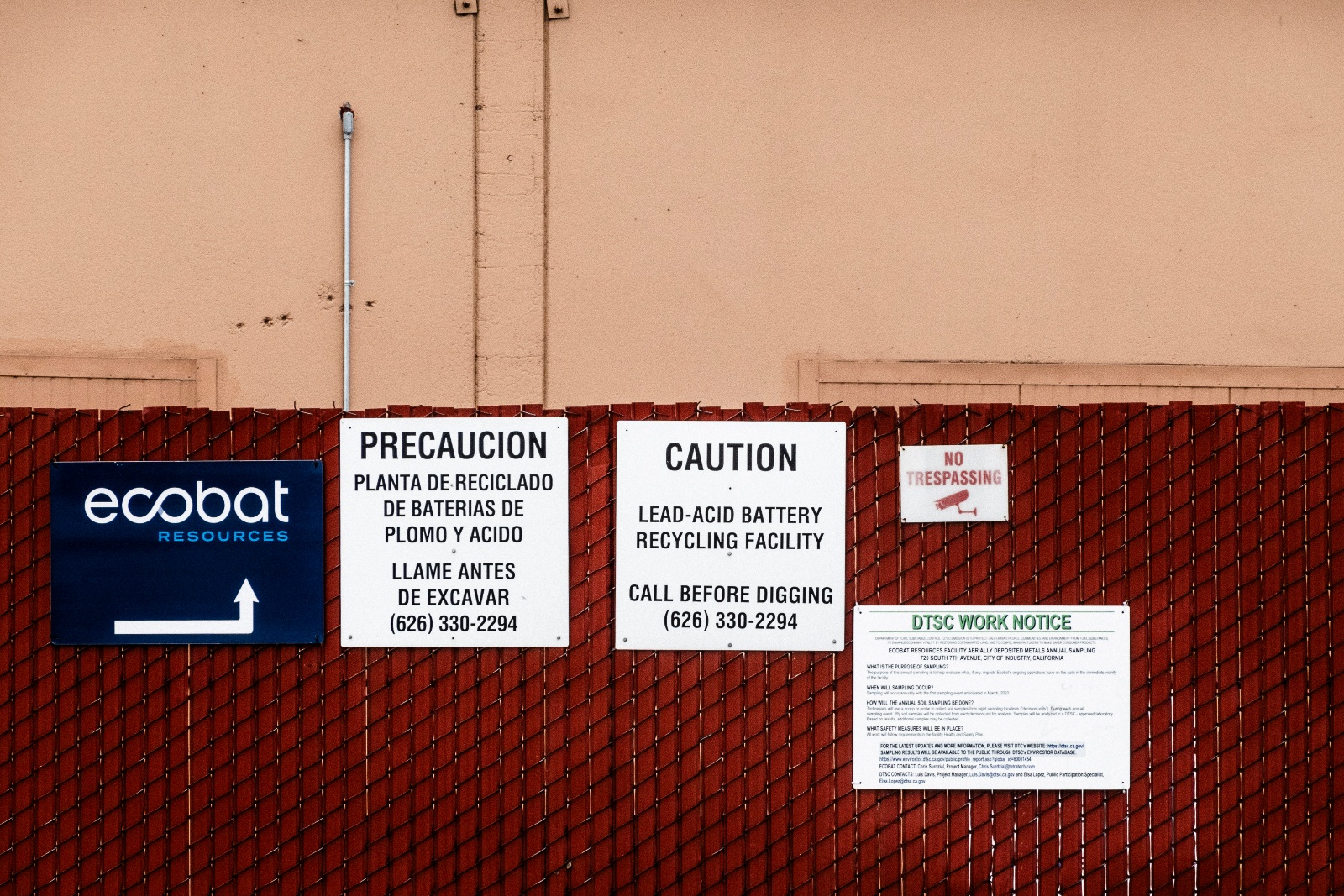
That outcome may embolden Ecobat to push back against potential legal and financial responsibility beyond the fenceline.
Air dispersion studies conducted by state scientists have indicated that historical emissions may have extended as far as 1.6 miles from the smelter. But the company maintains that “the evidence collected to date does not indicate that Ecobat’s facility has had an adverse effect on its neighbors.”
The lack of conclusive evidence about neighborhood level-contamination has motivated younger residents to start their own investigation.
Avocado Heights is a tight-knit community almost surrounded by City of Industry. But this unincorporated piece of the San Gabriel Valley is kind of an emotional opposite to Quemetco’s industrial-zoned hometown.
A grid along and across three blocks each way lines up neatly with ranch-style homes. Behind one peachy-pink house, Elena Brown-Vazquez and her brother Sam keep horses, goats, chickens and other animals.
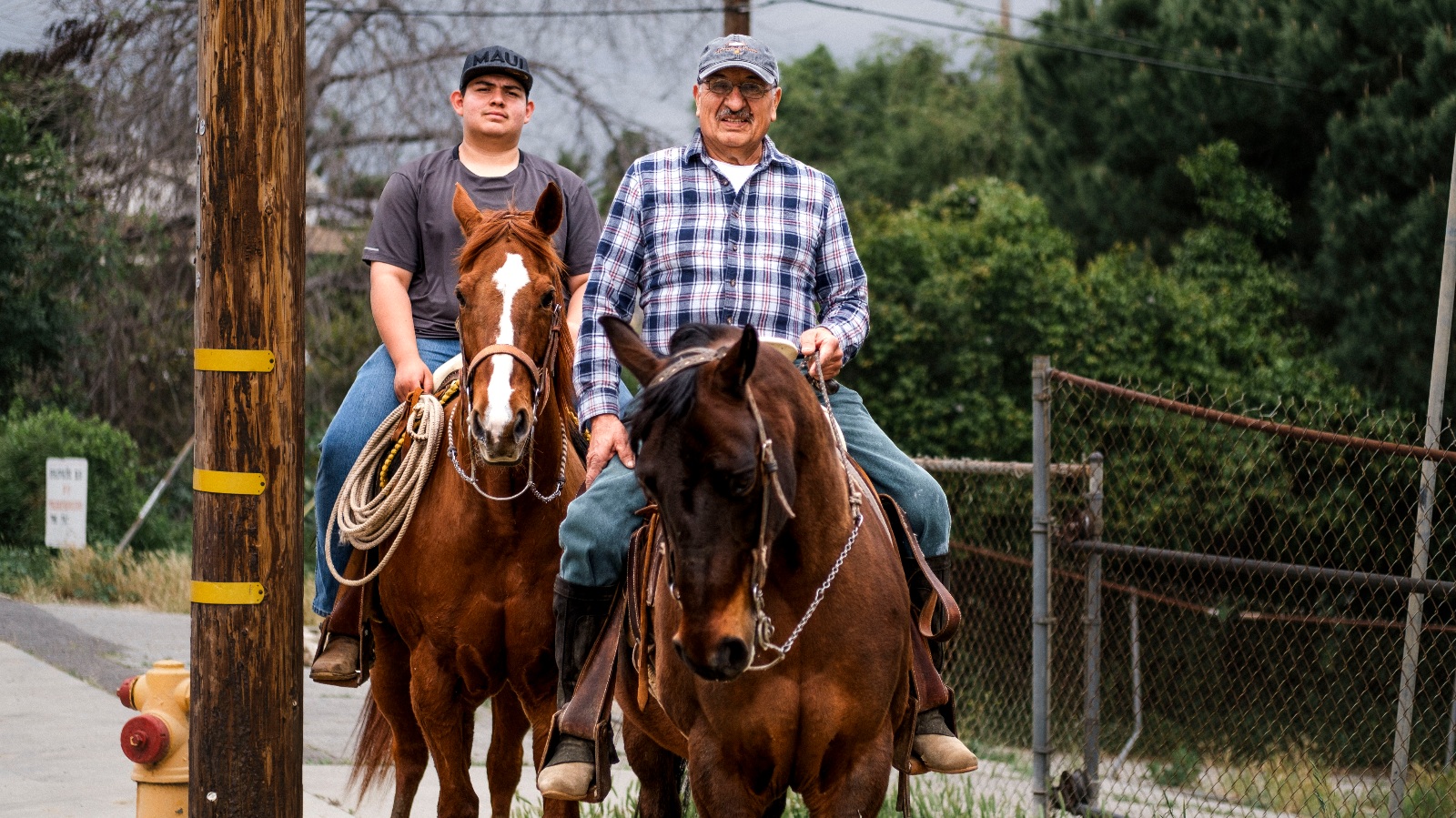
With dusty equestrian trails, Avocado Heights is a working-class neighborhood whose rhythm is informed by charrería culture: most people here have ties to Mexico, to places like Zacatecas or Jalisco, horse-loving country.
That was the draw for the Brown-Vasquez siblings, who moved here in 2020 to deepen their connection with their Mexican culture. Informal food vendors like mariscos carts came by during the pandemic. The open space allowed people to play music and grill and be near each other outside, safely. They found a sense of community.
But not long after arriving, the siblings received notice of a public meeting about the lead smelter. Elena saw kids running around yards, riding horses, and playing in the dirt, and she worried for herself and her neighbors.
Ecobat and DTSC “talk about doing due diligence and doing your job, but they’re not really even doing a good job of engaging the community,” she said.
Nayellie Diaz, a longtime La Puente resident and Sam Brown-Vasquez’s partner, nodded. She, Elena and Sam are among those who call themselves Avocado Heights Vaquer@s, who act “in defense of land, air, & water.” One of the group’s goals is to raise awareness about the pollution coming from the smelter in order to stop it.
“The problem for us on some level is, there’s uncertainty,” Sam said. He’s concerned about how much lead remains in soil, and where it came from. “The reality is right now, we could tell definitively if the lead that’s in the community is coming from [Ecobat],” he added. “But they won’t do that.”
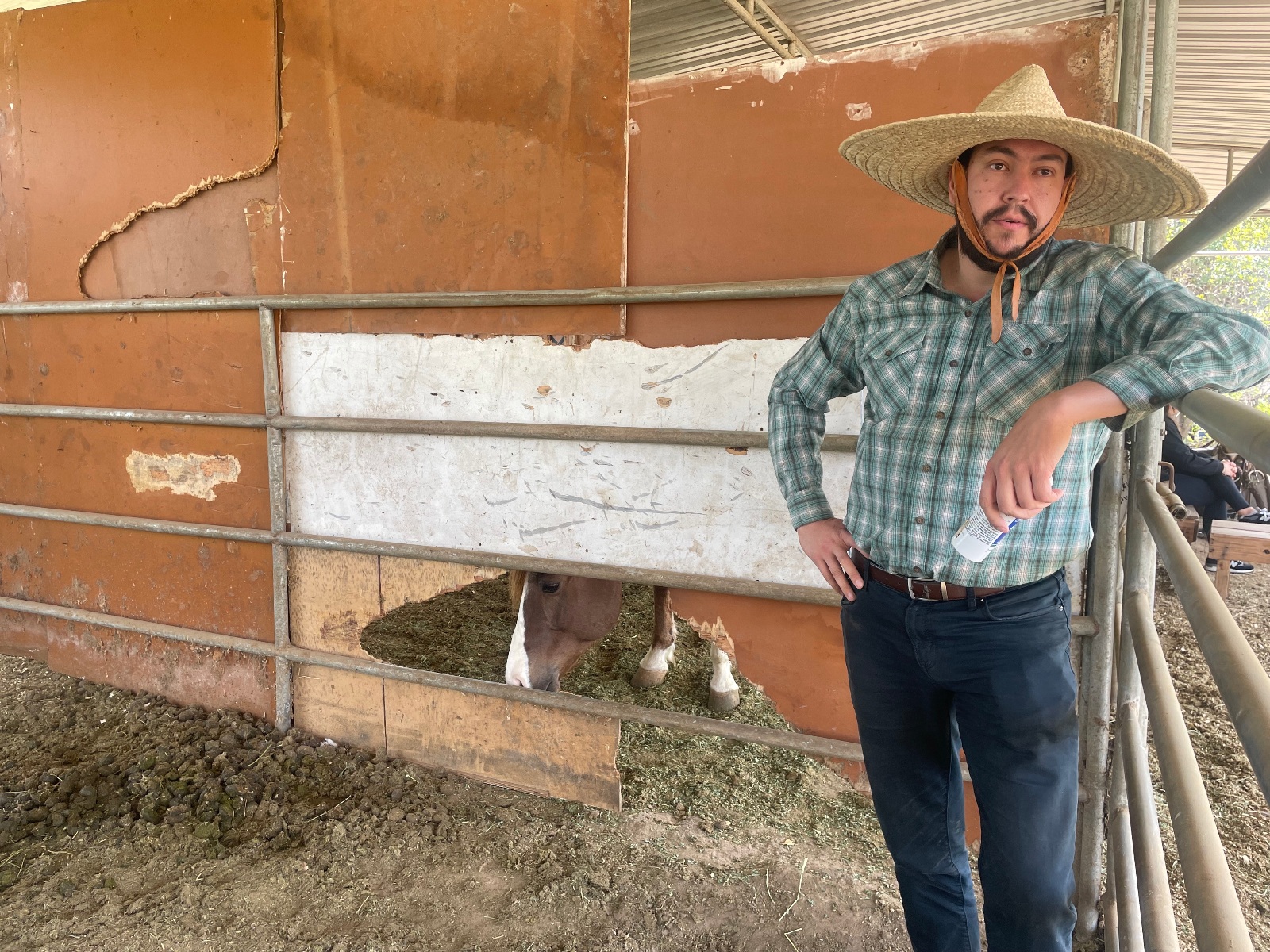
Last year, DTSC held a public workshop to explain its recent multimillion-dollar order against Ecobat, which included no funding to investigate soil contamination.
“We want more data,” Elena said.
At that meeting, Sam and Elena met Karen Valladares, a fourth-year Ph.D. student in environmental and occupational health at the University of California, Irvine, and Daniel Talamontes, a doctoral student in environmental studies at Claremont Graduate University.
Elena, a teacher, is working with the young researchers to gather soil samples from homes close to Ecobat. Talamontes describes the grant-funded work as “guerilla science.” A lab at the University of Southern California is testing the samples and the team members will interpret them.
“We are skilled enough, and knowledgeable, and we don’t trust [DTSC’s and Ecobat’s] methodology,” Talamontes said.
So far, Valladares and Talamontes said the overwhelming majority of soil samples have shown levels of lead above 80 parts per million, which echoes the earlier company-funded testing. She said a sizable chunk of the new samples are between 200 and 400 parts per million. The presence of arsenic in the soil, along with lead, suggests a source other than motor vehicles or paint, she said. It points to the smelter.
“There are natural levels of arsenic in the soil, but they’re very low,” Valladares said. “To have anything higher than that, it’s not the leaded gasoline. It’s coming from somewhere.”
DTSC said it is “working on a sampling strategy to determine the nature of the elevated (greater than 80 mg/kg) lead contamination observed in the community, as there are multiple potential sources of anthropogenic lead.”
At a meeting last fall, DTSC’s then-deputy director Todd Sax acknowledged that state regulators have “independent authority” to order Ecobat to do additional work right now — but he emphasized that they needed “sufficient evidence” to do so.
“Because that’s potentially a legal situation…we have to make absolutely certain that the data that we have would stand up in court because it may come to that,” Sax said, responding to a question about why soil testing takes so long.
“So we are being extra careful and thorough with our analyses and with the development of plans to make sure that whatever we do, it’s going to be scientifically defensible, it’s going to be right and it’s going to stick.”
Sax no longer works at DTSC and has taken a job at the California Air Resources Board.
As the permit process for Ecobat’s smelter drags on, the company’s lawyers have been busy.
Ecobat has filed two lawsuits involving California’s newly constituted Board of Environmental Safety, conceived by the state legislature to improve accountability at the DTSC. The board can hear public appeals to permits, as it did last year when the Clean Air Coalition challenged a limited permit the DTSC gave Ecobat for equipment the company installed without prior approval. The board sided with the neighborhood group. Ecobat has filed a civil complaint in Los Angeles County Superior Court against the board and the DTSC to appeal that decision. It’s also suing for public records related to that case in Sacramento County Superior Court.
A more aggressive tone — and strategy — is evident in these recent filings. In one, Ecobat’s lawyers called the neighborhood activists’ conduct at the appeal meeting in November “extreme by any measure,” saying the Clean Air Coalition, or CAC, “made a circus of the meeting.” Ecobat spokesman Kramer pointed to one moment, more than five hours into the six-hour meeting, where board members admonished someone for making obscene gestures not visible on a YouTube recording of the event. “It led the board into error,” the lawyers wrote.
The coalition, Ecobat’s lawyer wrote, “has blindly opposed Ecobat’s efforts to obtain regulatory approvals as part of a broader ‘delay strategy.’” Neighbors of the facility counter that the delay is the company’s fault. Since the company first submitted its permit renewal application in 2015, regulators have sent it back for corrections three times. Only recently did the DTSC deem the application complete.
Ecobat also has sent a letter to Earthjustice’s Johnson Meszaros, to “notify” her that it considered the coalition’s public testimony and Instagram comments about the company to be false and potentially defamatory.
“Ecobat has been exceptionally patient but CAC’s conduct is extreme by any measure,” the letter said. In Ecobat’s written response to Public Health Watch, Kramer said unfounded statements “can generate unfounded alarm in communities.”
Johnson Meszaros considers the letter a kind of harassment, meant to limit public participation in decisions about the smelter.
“This is something you see — oil companies have been using defamation against folks for a while now,” she said. “I think what they are telling us is they are prepared to sue community volunteers to break their will.”
DTSC and the Board of Environmental Safety did not comment on the litigation.
“Permit renewals are not a right,” Johnson Meszaros said. “They’re earned from your past behavior choices.”
Only China has more cars on the road than the U.S. As long as Americans drive gas-fueled cars, lead acid batteries aren’t going anywhere, according to environmental historian Jay Turner.
“We’ve created a world that we co-inhabit with this lead and we can’t walk away from that,” said Turner, whose book “Charged” explores the value of batteries in a clean energy transition. Now that we’ve brought lead into the manmade environment, Turner said, there’s an obligation to handle it safely.
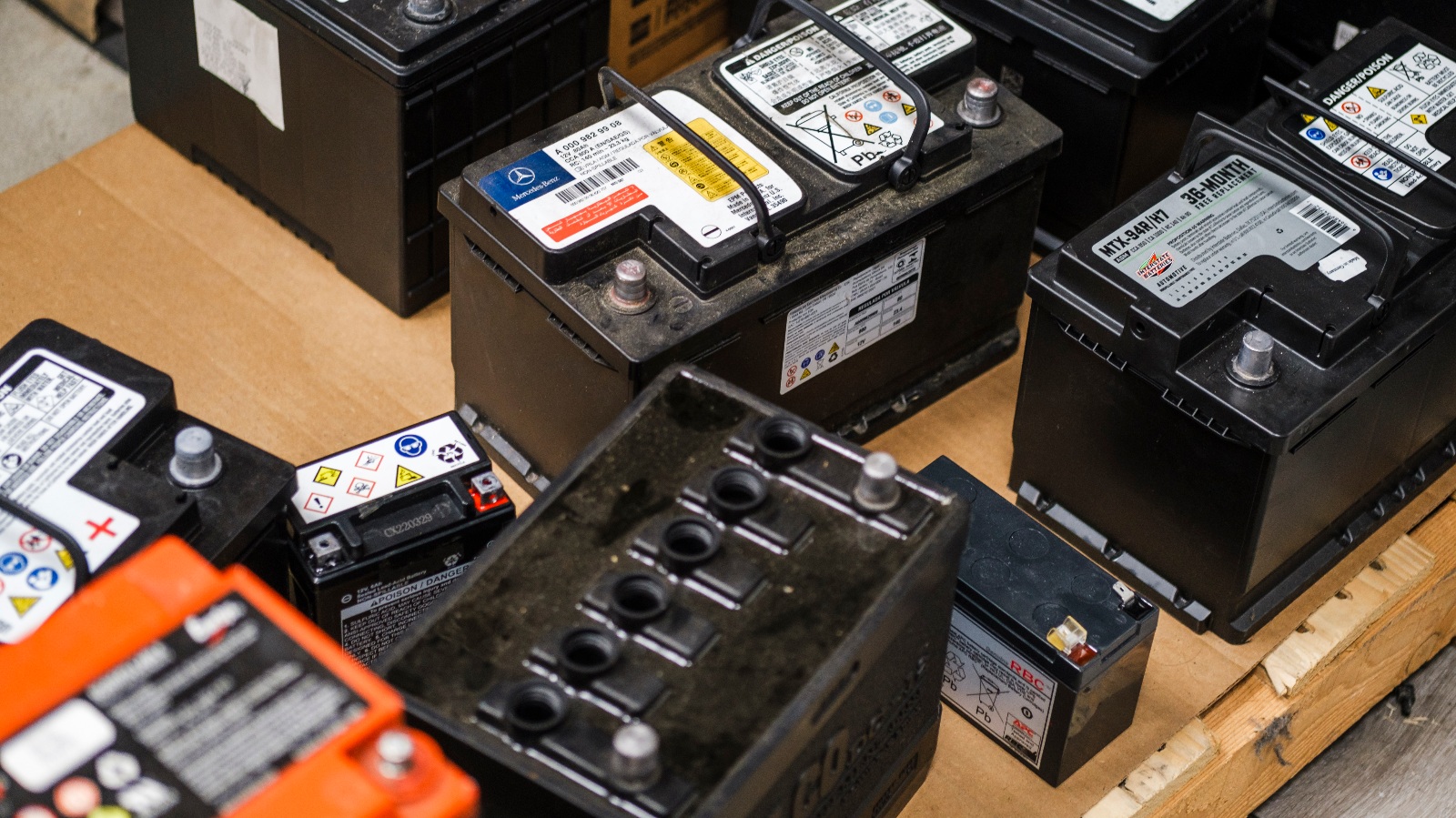
Doing that is more expensive in the U.S., where pollution controls are relatively tight, according to Perry Gottesfeld, an expert at the nonprofit OK International.
Just over a decade ago, a multinational conglomerate, Johnson Controls, built a new battery smelter in Florence, South Carolina. The $150 million facility was open for just under a decade and in that time it was fined by state regulators nine times. Johnson Controls spun off its battery division, which became a new company called Clarios. When the plant was shuttered in 2021, Clarios said in a filing with the Securities and Exchange Commission that it was 25% cheaper to recycle batteries at its plants in Mexico.
Gottesfeld said the U.S. doesn’t do enough to stop such offshoring. “You’re supposed to handle your own hazardous waste unless you have the inability to do so,” he said.
All of that puts more pressure on California, which has acknowledged its own outsourcing of hazardous waste — and which has 35 million registered vehicles on its roads.
It also presses down on the communities around the Ecobat facility. Avocado Heights resident Elena Brown-Vasquez has heard the argument before: California needs to clean up after itself. Battery recycling plants just south of the border are known to make workers sick. “We all get that a lot, we do,” she said.
But residents say they’re pushing back because their own health is in jeopardy, too.
They worry that if DTSC renews Ecobat’s permit, the South Coast Air Quality Management District could allow the company to boost daily production by 25%. Ecobat has been seeking to expand for years, but local advocates have been pushing back longer.
An early skeptic was Lilian Avery, who moved to Hedgepath Avenue in Hacienda Heights in 1956. Back then, she said during a 1996 DTSC public meeting, her neighbor was “an Armstrong rose garden; acres and acres of roses.” And then the smelter came in.
“I have had concern about Quemetco all these years,” Avery is quoted as saying in a transcript of the meeting. “They are trying hard to be good neighbors, but they have chosen the wrong plot.”
Public Health Watch is a nonprofit investigative news organization that covers weaknesses and injustices in the nation’s health systems and policies, exposes inequities and highlights solutions.
This story has been updated to reflect a late response from California’s Department of Toxic Substances Control.

